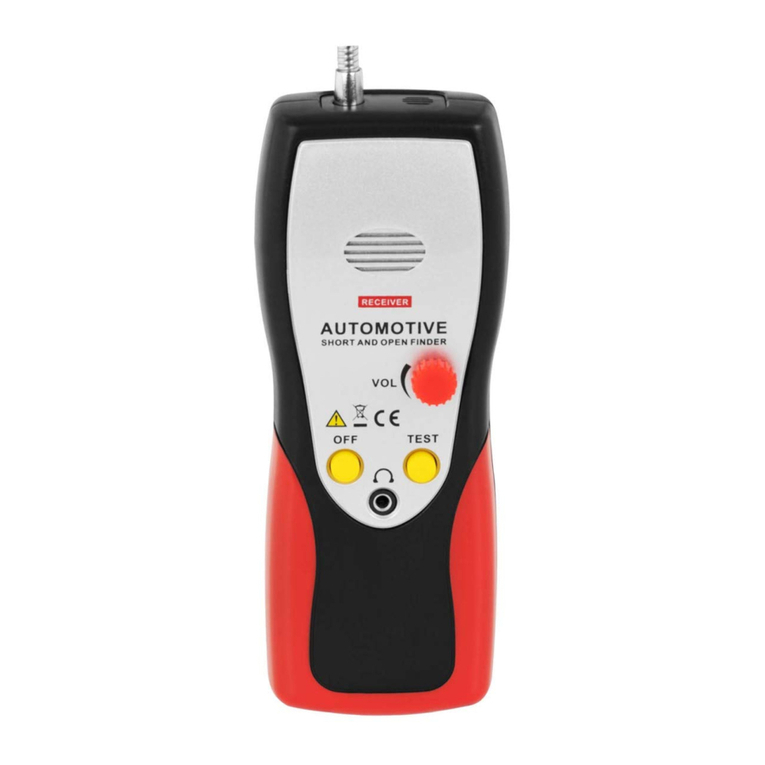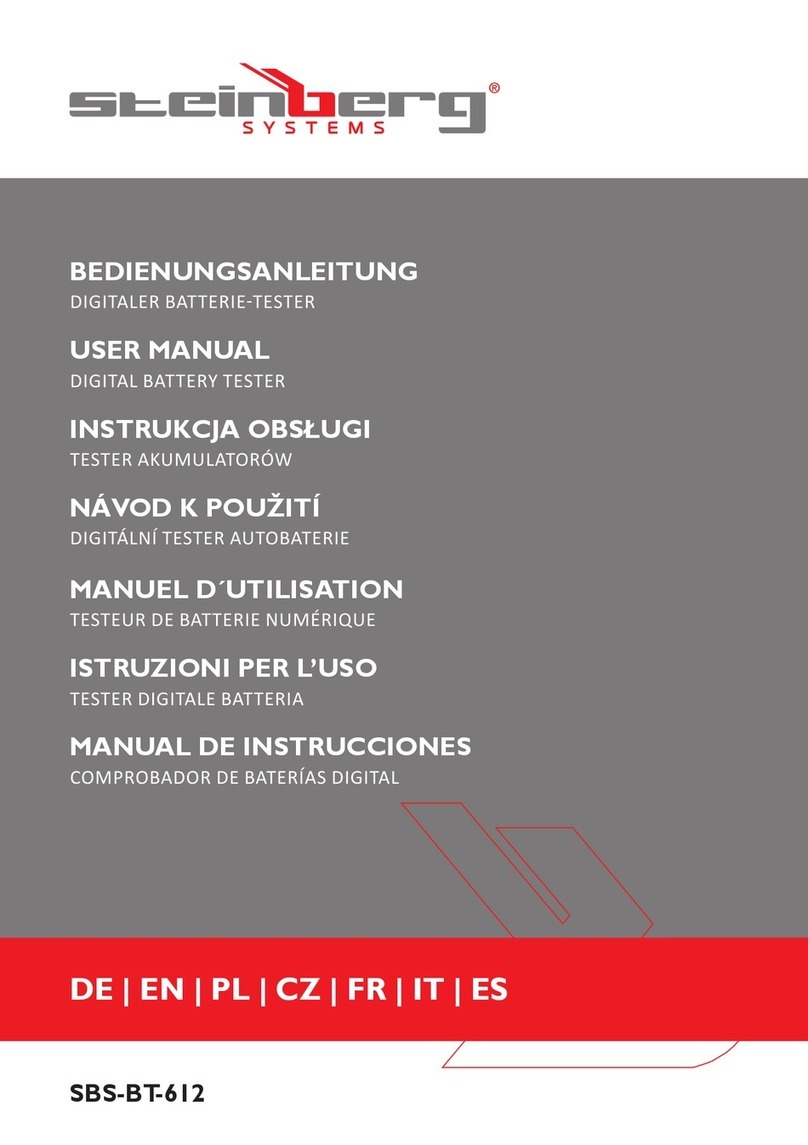
4 5
09.07.2019
DE
3.2. ARBEIT MIT DEM GERÄT
Automatisches Einschalten / Diagnosetest
• Das Kurzschließen der Sonden schaltet das
Gerät automatisch ein und wechselt in den
selbstdiagnostischen Testmodus.
• Diode [5] leuchtet – Spannung des Akkumulators im
normalen Bereich.
• Diode [5] blinkt oder erlöscht – Spannung des
Akkumulators < 2,4 ± 0,1 V.
• Der Autodiagnosetest kann nicht vor oder nach dem
Gebrauch des Geräts durchgeführt werden, wenn die
Spannung des Akkumulators niedrig ist.
• Wenn die automatische Abschaltung nicht
funktioniert, ersetzen Sie die Batterien.
AUTO HOLD-Funktion
• Der aktuelle Anzeigewert wird in der Anzeige
angezeigt, wenn die L1- und L2-Sonden von der
Messstelle getrennt werden.
Umschalten zwischen DCV/ACV-Modus
Schließen Sie die Sonden L1 und L2 kurz, um DCV-
Messungen durchzuführen, wenn das Gerät im ACV-
Messmodus gesperrt ist. Nach dem Erlöschen der 12V-LED
ist das Gerät messbereit.
Verfahren Sie genauso, wenn das Gerät im DCV-Messmodus
gesperrt ist und eine ACV-Messung erforderlich ist.
Wenn sich das Gerät automatisch abschaltet, ist es möglich,
ACV oder DCV unmittelbar nach dem Einschalten des
Geräts zu messen.
Verbinden Sie beide Sonden mit dem zu prüfenden
Objekt. Die Spannung wird durch die LEDs und die LCD-
Anzeige angezeigt. Die Spannungspolarität wird wie in der
folgenden Abbildung dargestellt angegeben.
Wenn die L2 Sonde ein positives (negatives) Potenzial
darstellt, werden die Dioden „+DC“ („-DC“) anzeigen.
Kontinuitätstest
VORSICHT Es muss sichergestellt werden, dass das
Prüfobjekt von der Stromversorgung getrennt ist.
Die LED zur Anzeige der Stromkreisdurchgang [4]
leuchtet auf und der Summer ertönt kontinuierlich. Im
Durchgangsprüfmodus arbeitet das Gerät wie bei der
Selbstdiagnose.
Phasenrotationstest
Verbinden Sie beide Sonden mit dem zu prüfenden Objekt.
• Wenn die LED „L“ leuchtet, ist die L2-Sonde mit
der Leitung A und die L1-Sonde mit der Leitung B
verbunden.
• Wenn die LED „R“ leuchtet, ist die L1-Sonde mit
der Leitung A und die L2-Sonde mit der Leitung B
verbunden.
Ein- und Ausschalten der Lampe
• Drücken Sie [E], um die Lampe ein- oder
auszuschalten.
• Wenn Sie [E] länger als 2 Sekunden drücken, wird die
Hintergrundbeleuchtung ein- oder ausgeschaltet.
HINWEIS: Die Lampe kann verwendet werden, wenn
das Gerät ausgeschaltet ist. Die Verwendung der Lampe
verkürzt die Lebensdauer der Batterie.
Batteriewechsel
Wenn die Power-LED [5] blinkt oder während eines
Selbstdiagnosetests erlischt. Gehen Sie wie folgt vor, um
die Batterien durch neue Batterien des gleichen Typs zu
ersetzen.
a) Entriegeln Sie das Batteriefach [F] (am einfachsten
mit einem münzförmigen Gegenstand).
verschlossen entsperrt
2.1. SICHERHEIT AM ARBEITSPLATZ
a) Halten Sie Ihren Arbeitsplatz sauber und
gut beleuchtet. Unordnung oder schlechte
Beleuchtung kann zu Unfällen führen. Handeln Sie
vorausschauend, beobachten Sie, was getan wird,
und nutzen Sie Ihren gesunden Menschenverstand
bei der Verwendung des Gerätes.
b) Benutzen Sie das Gerät nicht in explosionsgefährdeten
Bereichen, zum Beispiel in Gegenwart von
brennbaren Flüssigkeiten, Gasen oder Staub. Geräte
können unter Umständen Funken erzeugen, welche
Staub oder Dämpfe entzünden können.
c) Im Falle eines Schadens oder einer Störung sollte
das Gerät sofort ausgeschaltet und dies einer
autorisierten Person gemeldet werden.
d) Wenn Sie nicht sicher sind, ob das Gerät
ordnungsgemäß funktioniert, wenden Sie sich an
den Service des Herstellers.
e) Reparaturen dürfen nur vom Service des Herstellers
durchgeführt werden. Führen Sie keine Reparaturen
auf eigene Faust durch!
f) Zum Löschen des Gerätes bei Brand oder Feuer, nur
Pulverfeuerlöscher oder Kohlendioxidlöscher (CO2)
verwenden.
g) Halten Sie Kinder und Unbefugte fern; Unachtsamkeit
kann zum Verlust der Kontrolle über das Gerät
führen.
h) Überprüfen Sie regelmäßig den Zustand der
Sicherheitsinformationsaufkleber. Falls die Aufkleber
unleserlich sind, sollten diese erneuert werden.
i) Bewahren Sie die Gebrauchsanleitung für
den weiteren Gebrauch auf. Sollte das Gerät
an Dritte weitergegeben werden, muss die
Gebrauchsanleitung mit ausgehändigt werden.
j) Verpackungselemente und kleine Montageteile
außerhalb der Reichweite von Kindern aufbewahren.
k) Halten Sie das Gerät von Kindern und Tieren fern.
l) Im Laufe der Nutzung dieses Werkzeugs
einschlieβlich anderer Werkzeuge soll man sich nach
übrigen Betriebsanweisungen richten.
ACHTUNG! Obwohl das Gerät in Hinblick auf Sicherheit
entworfen wurde und über Schutzmechanismen
sowie zusätzlicher Sicherheitselemente verfügt,
besteht bei der Bedienung eine geringe Unfall-
oder Verletzungsgefahr. Es wird empfohlen, bei der
Nutzung Vorsicht und Vernunft walten zu lassen.
3. NUTZUNGSBEDINGUNGEN
Das Gerät ist zur Messung der Spannungsparameter
bestimmt.
Für alle Schäden bei nicht sachgemäßer Verwendung
haftet allein der Betreiber.
DE
Hinweis! Kinder und Unbeteiligte müssen bei der
Arbeit mit diesem Gerät gesichert werden.
2.3. SICHERE ANWENDUNG DES GERÄTS
a) Nicht verwendete Werkzeuge sind außerhalb
der Reichweite von Kindern sowie von Personen
aufzubewahren, welche weder das Gerät noch die
Anleitung kennen. In den Händen unerfahrener
Personen können diese Geräte eine Gefahr darstellen.
b) Halten Sie das Gerät stets in einem einwandfreien
Zustand. Im Falle eines Schadens muss das Gerät vor
Gebrauch in Reparatur gegeben werden.
c) Halten Sie das Gerät außerhalb der Reichweite von
Kindern.
d) Reparatur und Wartung von Geräten dürfen
nur von qualiziertem Fachpersonal und mit
Originalersatzteilen durchgeführt werden. Nur
so wird die Sicherheit während der Nutzung
gewährleistet.
e) Um die Funktionsfähigkeit des Gerätes zu
gewährleisten, dürfen die werksmäßig montierten
Abdeckungen oder Schrauben nicht entfernt werden.
f) Es ist untersagt, in den Aufbau des Geräts
einzugreifen, um seine Parameter oder Konstruktion
zu ändern.
g) Geräte von Feuer – und Wärmequellen fernhalten.
h) Setzen Sie die Schutzkappen auf die Sonden, wenn
das Gerät nicht benutzt wird. Dies verhindert die
Verletzungsgefahr bei unachtsamer Berührung.
i) Bauen Sie kein leeres Batteriefach in das Gerät ein.
j) Führen Sie keine Messungen an einem Stromkreis
durch, bei dem das elektrische Potenzial 690 V
überschreitet. (Wenn die gemessene Spannung 690
V überschreitet, leuchten alle Spannungs-LEDs auf.)
k) Verwenden Sie das Gerät nicht mit nassen oder
feuchten Händen, verwenden Sie es nicht bei Regen
und lassen Sie es nicht nass werden.
l) Fassen Sie das Gerät während der Messung nicht
über dem Gehäuse an.
m) Önen Sie während der Messungen nicht die
Batterieabdeckung.
n) Überprüfen Sie vor der Verwendung des Gerätes den
Betrieb an einem anderen bekannten Stromkreis.
o) Führen Sie keine Messungen durch, wenn das
Gehäuse des Gerätes beschädigt ist oder dessen
Metallteile freiliegen.
p) Seien Sie besonders vorsichtig, wenn die LED blinkt
oder die Spannung anzeigt.
q) Eine korrekte LED-Anzeige ist nur in einem
Temperaturbereich von -10 ° C bis 55 ° C (<85% rF)
gewährleistet.
r) Beachten Sie bei der Durchführung von Messungen
die allgemeinen Regeln und elektrotechnischen
Kenntnisse.
s) Bei der Spannungsmessung von mehr als 50 V muss
besondere Vorsicht gewahrt werden.
3.1. GERÄTEBESCHREIBUNG
1. LED Dioden: 12/24/50/120/230/400/690 V.
2. LED Dioden: Polarisation VDC
3. LED Dioden: Phasenwechsel L/R
4. LED Dioden: Kontinuität des Stromkreises
5. LED Dioden: Stromanschluss.
6. Hochspannungsanzeiger (≥ 50 V)
7. LCD Display
A. Sonde L1
B. Sonde L2
C. Gehäuse
D. Taschenlampe
E. Ein-/Ausschalter der Taschenlampe
F. Batteriebehälter
G. Klemme der Sonde
2.2. PERSÖNLICHE SICHERHEIT
a) Es ist nicht gestattet, das Gerät im Zustand der
Ermüdung, Krankheit, unter Einuss von Alkohol,
Drogen oder Medikamenten zu betreiben, wenn das
die Fähigkeit das Gerät zu bedienen, einschränkt.
b) Das Gerät darf nicht von Kindern oder Personen
mit eingeschränkten physischen, sensorischen und
geistigen Fähigkeiten oder ohne entsprechende
Erfahrung und entsprechendes Wissen bedient
werden. Dies ist nur unter Aufsicht einer für die
Sicherheit zuständigen Person und nach einer
Einweisung in die Bedienung der Maschine gestattet.
c) Seien Sie aufmerksam und verwenden Sie Ihren
gesunden Menschenverstand beim Betreiben
des Gerätes. Ein Moment der Unaufmerksamkeit
während der Arbeit kann zu schweren Verletzungen
führen.
d) Überschätzen Sie Ihre Fähigkeiten nicht. Sorgen Sie
für einen sicheren Stand während der Arbeit. Dies
gibt Ihnen eine bessere Kontrolle über das Gerät im
Falle unerwarteter Situationen.
e) Das Gerät ist kein Spielzeug. Kinder sollten in der
Nähe des Geräts unter Aufsicht stehen, um Unfälle
zu vermeiden.
Spannungsprüfung (Bipolarprüfung)ACHTUNG! Die Zeichnung von diesem
Produkt bendet sich auf der letzte Seite der
Bedienungsanleitung S. 31.
































